|
|
THE SPRUCES
White Spruce, Black Spruce, Norway
Spruce, Blue Spruce, and Douglas-fir
Family Pinaceae
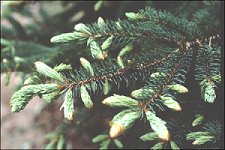 Spruces
have sharp, single NEEDLES. The CONES are papery. The spire-like FORM is not
as acute as balsam fir. It is difficult to tell spruces apart. White spruce
has longer needles that black spruce, but this doesn't help much unless you have two
samples in-hand to compare. The best way to distinguish between these two similar
species is to look at your feet. If you're standing in a wetland, it's probably
black spruce. If you're on an upland site, it's probably white spruce. Two alien spruces are common in the U.P., Norway
spruce and Colorado blue spruce. Mostly a family of the northern hemisphere, the
Pinaceae have 9 genera and about 210
species. The genus Picea is shown on this page. Other U.P.
genera are Pinus (pines), Larix (tamarack), Tsuga (hemlock), and Abies (firs).
Spruces
have sharp, single NEEDLES. The CONES are papery. The spire-like FORM is not
as acute as balsam fir. It is difficult to tell spruces apart. White spruce
has longer needles that black spruce, but this doesn't help much unless you have two
samples in-hand to compare. The best way to distinguish between these two similar
species is to look at your feet. If you're standing in a wetland, it's probably
black spruce. If you're on an upland site, it's probably white spruce. Two alien spruces are common in the U.P., Norway
spruce and Colorado blue spruce. Mostly a family of the northern hemisphere, the
Pinaceae have 9 genera and about 210
species. The genus Picea is shown on this page. Other U.P.
genera are Pinus (pines), Larix (tamarack), Tsuga (hemlock), and Abies (firs).
 WHITE
SPRUCE (Picea glauca)
WHITE
SPRUCE (Picea glauca)
Other
Names: Canadian Spruce, Eastern Spruce, Black Hills Spruce, Cat Spruce
Key ID Features: Needles, Cones, Habitat, Twigs
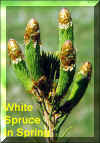
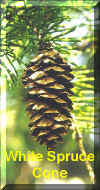
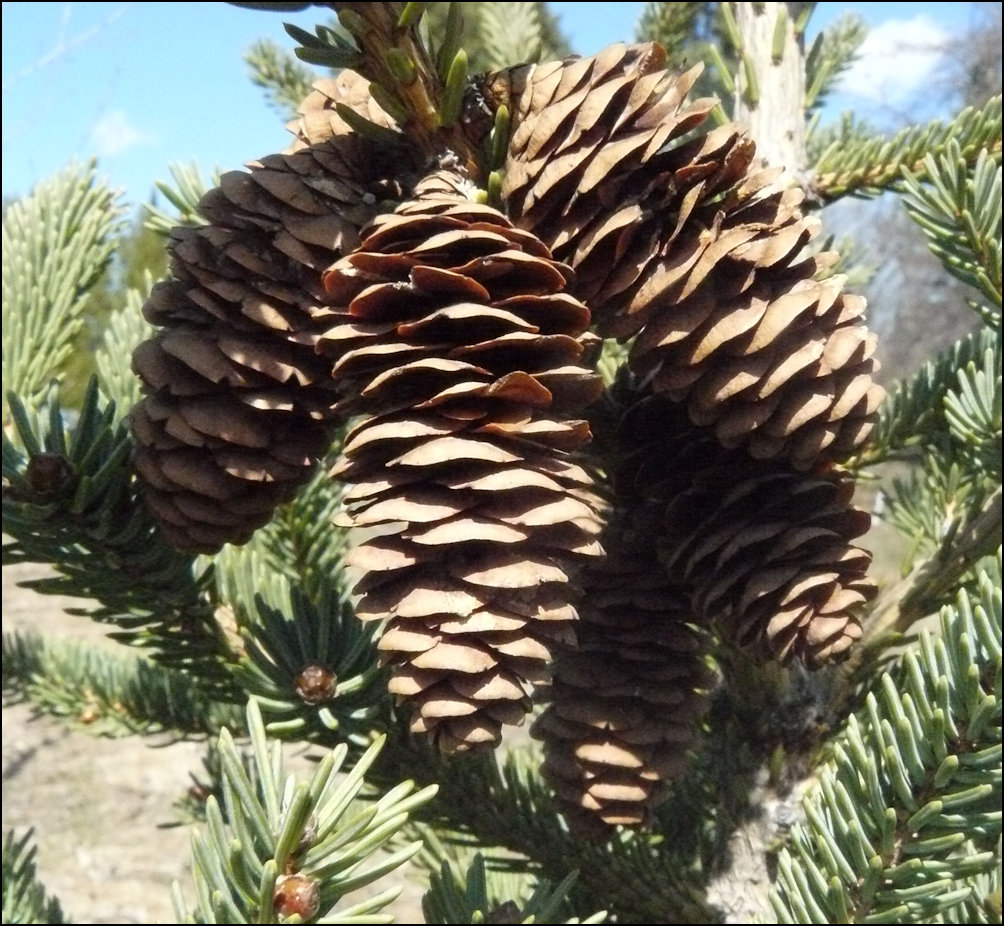
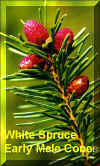
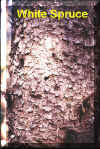
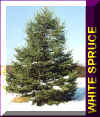


White spruce NEEDLES are
1/3 to 3/4 inches long. They are sharp, making them uncomfortable to handle without
gloves. Needles sometimes have a bluish cast similar to Colorado blue spruce.
Recent TWIG growth is hairless. The papery CONES are about two inches long.
The scaly BARK is light gray or brown. White spruce is commonly 60-80 feet HEIGHT,
although can reach 120 feet under optimum conditions. The species is generally found
on UPLAND SITES, often in ASSOCIATION with balsam fir or aspen. It rarely occurs as
the dominant tree in a forest stand, except in plantations. Common pests: needle galls, spruce budworm, spider mites, eastern spruce gall adelgid, Rhizosphaera, Chrysomyxa, Cytospora, dwarf mistletoe, red heart, Polypores, Tomentosus.
 BLACK
SPRUCE (Picea mariana)
BLACK
SPRUCE (Picea mariana)
Other
Names: Bog/Swamp Spruce, Eastern Spruce, Shortleaf Spruce
Key ID Features: Needles, Cones, Habitat, Twigs
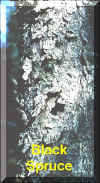
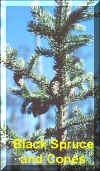
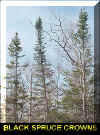



Black spruce NEEDLES are 1/4
to 3/4 inches long, also sharp to the touch. Recent TWIG growth often has small,
fine hairs. These hairs tend to rub off by mid-winter. The papery CONES are
about 1.5 inches long. The scaly BARK is dark gray. On BOG SITES of low
fertility, black spruce can remain stunted for decades. On better sites, the tree
may grow to 60 feet or so. Black spruce is most commonly found in WETLAND TYPES,
often in pure stands or mixed
with tamarack or northern white cedar. Common pests: needle galls, spruce budworm, spider mites, eastern spruce gall adelgid, Rhizosphaera, Chrysomyxa, Cytospora, dwarf mistletoe, red heart, Polypores, Tomentosus.
 NORWAY SPRUCE (Picea abies)
NORWAY SPRUCE (Picea abies)
Other
Names: European Spruce, Scandinavian Spruce
Key ID Features: Needles, Cones, Droopy Branches, Near Homes
Norway spruce closely resembles white spruce. DROOPY BRANCHES are a good identifier from a distance. The long 4-7 inch papery CONES are probably the easiest way to identify Norway spruce. The species is the dominant commercial species in northern Europe. In the USA, it has been established in plantations and is a common ornamental. Growth rates are rapid and HEIGHTS of 80-90 feet are normal. Trees are quite prone to attacks from gall aphids, which is usually just a visual problem and not life-threatening. Common pests: needle galls, spruce budworm, spider mites, eastern spruce gall adelgid, Rhizosphaera, Chrysomyxa, Cytospora, dwarf mistletoe, red heart, Polypores, Tomentosus.
COLORADO BLUE
SPRUCE (Picea pungens)
Other Names: Blue Spruce
Key ID Features: Blue-cast Needles, Cones, Near Homes
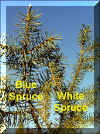
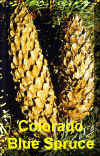
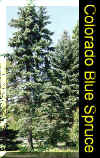
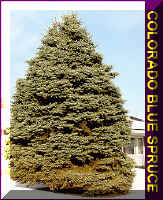
Blue spruce is a native of the Rocky Mountains and is a favorite
ORNAMENTAL due to the bluish cast on the NEEDLES. A healthy white spruce sometimes
displays a bluish cast, too. The needles are a little longer than most spruces,
sometimes over an inch long. They are also stiffer and more painful to handle than
other spruces. The CONES are light-colored and may grow to 3 inches long.
Mature trees may reach 70-80 feet in HEIGHT and take on a scruffy appearance. Trees
are quite prone to attacks from gall aphids, which is usually just a visual problem and
not life-threatening. Common pests: needle galls, spruce budworm, spider mites, eastern spruce gall adelgid, Rhizosphaera, Chrysomyxa, Cytospora, dwarf mistletoe, red heart, Polypores, Tomentosus.
DOUGLAS-FIR
(Pseudotsuga menziezii)
Other Names: Douglas-spruce, Red Fir, Oregon Fir, Doug-fir
Key ID Features: Needles, Cones, Bark
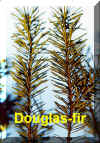
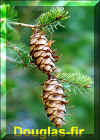
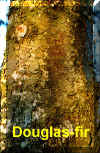
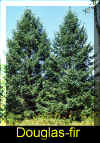
Douglas-fir is neither a
fir or a spruce but is easily mistaken for one. It is a native of the rocky
mountains and the Pacific coast mountain ranges. It is not a component of the U.P.
forest but has been planted on a number of old farm homesteads and as an ornamental in
towns. The NEEDLES are spruce-like but not as stiff and have a different
smell. The CONES are quite different in that they have "birds tails"
sticking out from under the cone scales. The BARK is dark gray with flat plates, 2-3
inches in size, that break away.
Click HERE
to return to the Conifer Key.
Click HERE to return to the home page.
A note about the images on this website, click here.
This site created and maintained by Bill Cook, MSU Extension Forester for the Upper Peninsula of Michigan. Editing and modification is ongoing. Submit suggestions, questions, and corrections to cookwi@msu.edu or call 906-786-1575.